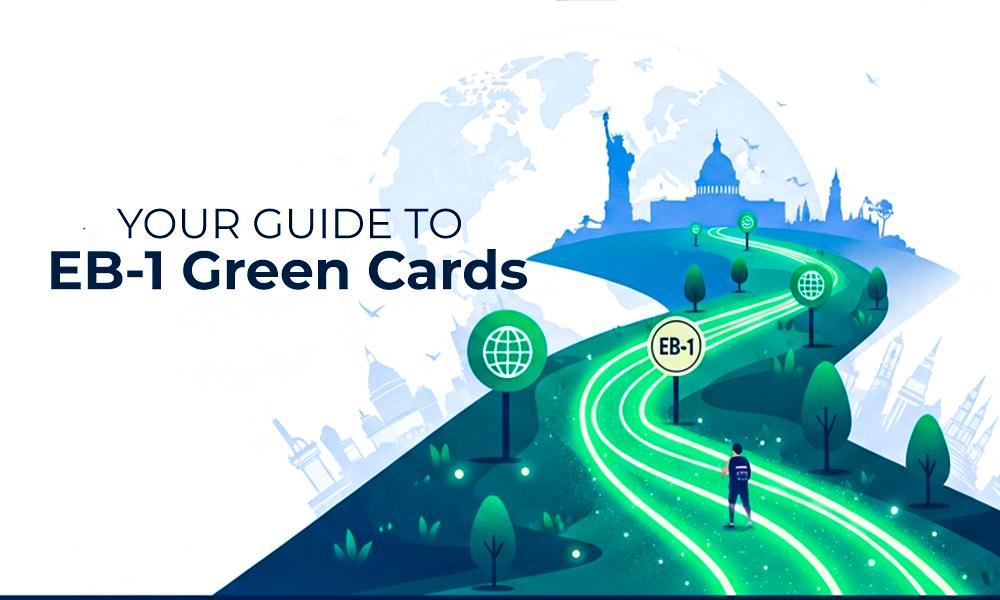The EB-1 category is the first-preference employment-based green card classification for “priority workers.” It includes three sub-categories:
- EB-1A for individuals with extraordinary ability,
- EB-1B for outstanding professors and researchers, and
- EB-1C for certain multinational managers and executives.
All three EB-1 options share two major advantages: they are in the highest employment-based preference, and they do not require labor certification (PERM), which often makes them faster and more predictable than many EB-2 or EB-3 cases.
This overview explains EB-1A vs EB-1B vs EB-1C in simple terms so both lawyers and non-lawyers can see who each category is for, what the main requirements are, and how sponsorship and evidence differ.
EB-1A: Extraordinary Ability
EB-1A is for people at the very top of their field in the sciences, arts, education, business, or athletics. U.S. regulations define “extraordinary ability” as a level of expertise indicating that you are one of a small percentage who has risen to the top of the field, with sustained national or international acclaim.
You can qualify in one of two ways:
- By showing a one-time major internationally recognized award (such as a Nobel Prize), or
- By meeting at least three out of ten regulatory criteria, which cover things like significant prizes, selective memberships, published material about you, judging others’ work, original contributions of major significance, scholarly publications, leading roles, and high compensation compared to peers.
You must also show that you intend to continue working in your area of expertise in the United States.
One of the biggest advantages of EB-1A is that you can self-petition. You do not need a U.S. employer to sponsor you, although documentation such as contracts, letters of intent, or a business plan can help demonstrate your future work. This makes EB-1A especially attractive for entrepreneurs, independent artists, consultants, and others who want immigration options that are not tied to a particular employer.
EB-1B: Outstanding Professors and Researchers
EB-1B is designed for academics with a strong record of teaching or research who are recognized internationally as outstanding in a specific academic field. Typical candidates include tenure-track or tenured professors and senior researchers whose work is widely cited or relied upon by other experts.
To qualify, you generally must:
- Have at least three years of teaching or research experience in the field; and
- Provide evidence that you are internationally recognized as outstanding by meeting at least two out of six listed criteria (for example, major academic awards, selective memberships, published material about your work, participation as a judge of others’ research, original scientific contributions, and authorship of scholarly books or articles).
You must also have a permanent job offer from a U.S. employer for a tenured, tenure-track, or comparable permanent research position. The U.S. employer, not the professor or researcher, files the EB-1B I-140 petition with USCIS.
EB-1B is often the best fit when your profile is clearly academic, you already hold (or are about to hold) a long-term faculty or research position in the United States, and you can document the impact of your scholarship through publications, citations, and expert letters.
EB-1C: Multinational Managers and Executives
EB-1C is for managers and executives who work for multinational companies and are being transferred to a related U.S. entity such as a parent, subsidiary, affiliate, or branch. It is often used as the permanent-residence counterpart to the L-1A intracompany transferee visa.
To qualify, you generally must:
- Have been employed outside the United States for at least one continuous year in the three years before the petition (or before your most recent admission to the U.S.) by a qualifying foreign company;
- Have worked abroad in a managerial or executive capacity, meaning you directed the organization, a department, or a key function, supervised professional staff, or exercised wide decision-making authority; and
- Be coming to the United States to work for the related U.S. entity in a similar managerial or executive role.
Your U.S. employer must file the EB-1C I-140 petition and provide corporate documents proving the qualifying relationship, business operations, and your senior role (for example, organizational charts and detailed job descriptions). Unlike many other employment-based categories, EB-1C also does not require PERM labor certification.
How to Decide Which EB-1 Category Fits You
Choosing between EB-1A, EB-1B, and EB-1C is really about matching the legal standard to your actual career and the evidence you can produce. A practical way to decide is to look at your profile, your documentation, and your sponsorship and long-term plans.
1. Start with your professional profile
Ask where your day-to-day work naturally fits:
If your career revolves around research and teaching, with peer-reviewed publications, citations, grants, and conference invitations, EB-1B is often the most natural starting point because its criteria are written for academic careers.
If you are a corporate leader managing teams, departments, or business units across borders and your company wants you in a long-term U.S. leadership role, EB-1C is usually the best match.
If your recognition is broad and individual, for example, as a well-known artist, athlete, entrepreneur, or industry expert whose name is widely associated with excellence, EB-1A is generally the category to explore first.
This initial mapping often narrows the realistic options to one or two categories.
2. Test your strongest evidence
Next, take an honest inventory of what you can prove on paper, not just what you have done in practice:
EB-1A leans heavily on outward-facing recognition: major awards, media coverage, judging roles, and evidence that your contributions place you in the top tier of your field.
EB-1B relies on academic markers: publications, citation counts, independent expert letters, and proof that other researchers rely on your work.
EB-1C is driven by corporate documentation: organizational charts, job descriptions, decision-making authority, and proof of the qualifying multinational structure.
Even if you technically meet more than one standard, the category where your evidence is densest and clearest is usually the one with the strongest chance of approval.
3. Consider sponsorship and long-term plans
Finally, think about how much you want to rely on a single employer:
EB-1B and EB-1C both require a committed U.S. employer willing to file the petition and keep you in the offered role. That can be ideal if your university or company is stable and supportive, but it ties your immigration strategy to that institution’s future.
EB-1A gives you more control because you can self-petition. You decide when to file, and you are not locked into one employer. If you expect to change employers, build your own business, or work independently, that flexibility can be a major advantage.
Some people genuinely fit more than one EB-1 path. A senior scientist in industry, for example, might qualify for EB-1B as an outstanding researcher, EB-1A based on extraordinary contributions, or EB-1C if they also hold a high-level managerial role in a multinational group. In that situation, the best approach is usually to focus on the category where your everyday work most closely matches the legal definition and where your documentation is strongest, ideally with guidance from an experienced U.S. immigration attorney.
FAQs
Q1. Do all EB-1 categories avoid PERM labor certification?
Yes. EB-1A, EB-1B, and EB-1C are all exempt from PERM, which is one reason they are often faster than many EB-2 or EB-3 options.
Q2. Which EB-1 category allows self-petitioning?
Only EB-1A allows self-petitioning. EB-1B and EB-1C both require a U.S. employer to file the petition and provide a qualifying job offer.
Q3. Can my family get green cards with me if my EB-1 is approved?
Yes. Your spouse and unmarried children under 21 can apply as derivative beneficiaries based on your approved EB-1 petition and obtain permanent residence as well.
Q4. Can I switch from one EB-1 route to another?
In some cases, yes. For example, someone who filed EB-1B might later decide to file EB-1A if their independent recognition grows, or an L-1A executive may later pursue EB-1C. Each petition, however, must independently meet the criteria for that category.
References
U.S. Citizenship and Immigration Services (USCIS) – Employment-Based Immigration: First Preference (EB-1)
- 8 C.F.R. § 204.5(h), (i), (j) – Regulations governing EB-1A, EB-1B, and EB-1C
- USCIS Policy Manual – Volume 6, Part F (Employment-Based Classifications)

